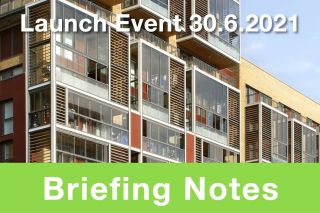
www.buildingsandcities.org/insights/news/mass-retrofit.html
Making Mass Retrofit a Reality

A webinar from CREDS and Buildings & Cities
There is a large gulf between current slow retrofitting rates and the portion of domestic buildings that rapidly need intervention to meet climate targets. This webinar reflects on key findings from a recent Buildings & Cities special issue which begins to address the gap by focusing on delivering retrofit at scale. Co-hosted with the Centre for Research into Energy Demand Solutions (CREDS). Registration: https://bit.ly/3DCrfrJ
Key questions
- What policy initiatives can create the right conditions (energy service models, business retrofit models and consumer demand) to encourage mass retrofit?
- What coordination between actors (central or local government, private sector companies, professional organisations) is needed to enable mass retrofit?
- What specific capabilities and capacities need to be created in construction supply chains? How can these be supported?
Agenda
Welcome Nick Eyre, Director of CREDS &
University of Oxford
Introduction to the Special Issue, Faye Wade, University of Edinburgh
Part 1: Policy & governance for retrofitting
Retrofitting at scale: comparing transition experiments in
Scotland and the Netherlands, Petra Hofman, Tilburg University, NL & Faye Wade, University of Edinburgh, UK
Housing retrofit: six types of local authority energy service
models, Jan Webb MBE, University of Edinburgh, UK
Discussant: Erwin Mlecnik, TU Delft, NL
Part 2: Developing supply chain capacity
Domestic retrofit supply chain initiatives and business
innovations: an international review, Joanne Wade OBE, The Association for Decentralised
Energy and Chair of the Advisory Board for CREDS, UK
Domestic retrofit: understanding capabilities of micro-enterprise
building practitioners, Kate Simpson, Imperial College London, UK
Discussant: Veronika Schröpfer, Architects' Council of Europe, BE
Part 3: Respondents
Lord Deben, Chair, Climate Change Committee, UK
Stefan Moser, European Commission, DG ENERGY, Head of Unit: Buildings and Products (ENER.B.3)
Part 4: Q&A
Chaired by Richard Lorch, Editor in Chief, Buildings & Cities
Background
Domestic buildings account for 24% of global anthropogenic greenhouse gas emissions (Lucon et al., 2014), and the vast majority of existing buildings are likely to still be in use in 2050. Consequently, retrofitting domestic buildings is essential for meeting targets to mitigate the catastrophic impacts of our changing climate. Retrofitting includes a combination of improving the building fabric to reduce the need for heating and cooling, and changing building services (heating, cooling, ventilation, hot water, electricity) to carbon free systems.The International Energy Agency (IEA) have indicated that one in five buildings worldwide need to be retrofitted to be zero carbon ready by 2030 (IEA, 2021). However, current rates of retrofitting are far lower than necessary for achieving global net zero climate targets. For example, across the EU, deep retrofits that reduce energy consumption by at least 60% are carried out in only 0.2% of the building stock per year and in some regions, energy retrofitting is virtually absent (EC, 2020).
Successful retrofitting will only be achieved through aligning political, economic, social and technical systems. Policy and governance, in particular, can provide appropriate conditions for mass retrofit. Central governments have the capacity to create and implement targets, tools and financial support, but retrofitting schemes customised to local circumstances can be more successful than nation-wide strategies (Gillich, et al., 2018). However, there is uncertainty around the capacity of local schemes to be scaled up. Additionally, successful energy retrofitting will require a 'house as a system' approach (Stanislas et al., 2011), which recognises the building envelope as a single thermal unit (Clarke et al., 2017). The Repair, Maintenance and Improvement (RMI) sector currently undertakes the majority of domestic renovation work (e.g. extensions, kitchen and bathroom refurbishments), and would be well positioned to contribute to scaling energy retrofitting. However, the sector is currently characterised by fragmentation and skill sets restricted according to discipline or technology. There are still unanswered questions around how such actors can be supported to develop supply chains for retrofitting at scale.
References
Clarke, L., Gleeson, C., & Winch, C. (2017). What kind of expertise is needed for low energy construction? Construction Management and Economics, 35(3), 78-89. https://doi.org/10.1080/01446193.2016.1248988
EC, (2020). A renovation wave of Europe, Greening our buildings, creating jobs, improving lives. European Commission. Available at: https://ec.europa.eu/energy/topics/energy-efficiency/energy-efficient-buildings/renovation-wave_en
Gillich, A., Sunikka-Blank, M., & Ford, A. (2018). Designing an 'optimal' domestic retrofit programme. Building Research and Information, 46(7), 767-778. https://doi.org/10.1080/09613218.2017.1368235
IEA, (2021). Net zero by 2050 hinges on a global push to increase energy efficiency. International Energy Agency. Published: 10 June 2021. Available at: https://www.iea.org/articles/net-zero-by-2050-hinges-on-a-global-push-to-increase-energy-efficiency
Lucon O., D. Ürge-Vorsatz, A. Zain Ahmed, H. Akbari, P. Bertoldi, L. F. Cabeza, N. Eyre, A. Gadgil, L. D. D. Harvey, Y. Jiang, E. Liphoto, S. Mirasgedis, S. Murakami, J. Parikh, C. Pyke, and M. V. Vilariño, (2014). Buildings. In: Climate Change 2014: Mitigation of Climate Change. Contribution of Working Group III to the Fifth Assessment Report of the Intergovernmental Panel on Climate Change [Edenhofer, O., R. Pichs-Madruga, Y. Sokona, E. Farahani, S. Kadner, K. Seyboth, A. Adler, I. Baum, S. Brunner, P. Eickemeier, B. Kriemann, J. Savolainen, S. Schlömer, C. von Stechow, T. Zwickel and J.C. Minx (eds.)]. Cambridge University Press, Cambridge, United Kingdom and New York, NY, USA
Stanislas, N., Janda, K. B., & Killip, G. (2011). Building expertise: A system of professions approach to low-carbon refurbishment in the UK and France. Proceedings of ECEEE 2011 Summer Study - Belambra Presquile de Giens, France
Latest Peer-Reviewed Journal Content
Youth engagement in urban living labs: tools, methods and pedagogies
N Charalambous, C Panayi, C Mady, T Augustinčić & D Berc
Co-creating urban transformation: a stakeholder analysis for Germany’s heat transition
P Heger, C Bieber, M Hendawy & A Shooshtari
Placemaking living lab: creating resilient social and spatial infrastructures
M Dodd, N Madabhushi & R Lees
Church pipe organs: historical tuning records as indoor environmental evidence
B Bingley, A Knight & Y Xing
A framework for 1.5°C-aligned GHG budgets in architecture
G Betti, I Spaar, D Bachmann, A Jerosch-Herold, E Kühner, R Yang, K Avhad & S Sinning
Net zero retrofit of the building stock [editorial]
D Godoy-Shimizu & P Steadman
Co-learning in living labs: nurturing civic agency and resilience
A Belfield
The importance of multi-roles and code-switching in living labs
H Noller & A Tarik
Researchers’ shifting roles in living labs for knowledge co-production
C-C Dobre & G Faldi
Increasing civic resilience in urban living labs: city authorities’ roles
E Alatalo, M Laine & M Kyrönviita
Co-curation as civic practice in community engagement
Z Li, M Sunikka-Blank, R Purohit & F Samuel
Preserving buildings: emission reductions from circular economy strategies in Austria
N Alaux, V Kulmer, J Vogel & A Passer
Urban living labs: relationality between institutions and local circularity
P Palo, M Adelfio, J Lundin & E Brandão
Living labs: epistemic modelling, temporariness and land value
J Clossick, T Khonsari & U Steven
Co-creating interventions to prevent mosquito-borne disease transmission in hospitals
O Sloan Wood, E Lupenza, D M Agnello, J B Knudsen, M Msellem, K L Schiøler & F Saleh
Circularity at the neighbourhood scale: co-creative living lab lessons
J Honsa, A Versele, T Van de Kerckhove & C Piccardo
Positive energy districts and energy communities: how living labs create value
E Malakhatka, O Shafqat, A Sandoff & L Thuvander
Built environment governance and professionalism: the end of laissez-faire (again)
S Foxell
Co-creating justice in housing energy transitions through energy living labs
D Ricci, C Leiwakabessy, S van Wieringen, P de Koning & T Konstantinou
HVAC characterisation of existing Canadian buildings for decarbonisation retrofit identification
J Adebisi & J J McArthur
Simulation and the building performance gap [editorial]
M Donn
Developing criteria for effective building-sector commitments in nationally determined contributions
P Graham, K McFarlane & M Taheri
Join Our Community

The most important part of any journal is our people – readers, authors, reviewers, editorial board members and editors. You are cordially invited to join our community by joining our mailing list. We send out occasional emails about the journal – calls for papers, special issues, events and more.
We will not share your email with third parties. Read more



Latest Commentaries
COP30 Report
Matti Kuittinen (Aalto University) reflects on his experience of attending the 2025 UN Conference of the Parties in Belém, Brazil. The roadmaps and commitments failed to deliver the objectives of the 2025 Paris Agreement. However, 2 countries - Japan and Senegal - announced they are creating roadmaps to decarbonise their buildings. An international group of government ministers put housing on the agenda - specifying the need for reduced carbon and energy use along with affordability, quality and climate resilience.
Building-Related Research: New Context, New Challenges
Raymond J. Cole (University of British Columbia) reflects on the key challenges raised in the 34 commissioned essays for Buildings & Cities 5th anniversary. Not only are key research issues identified, but the consequences of changing contexts for conducting research and tailoring its influence on society are highlighted as key areas of action.